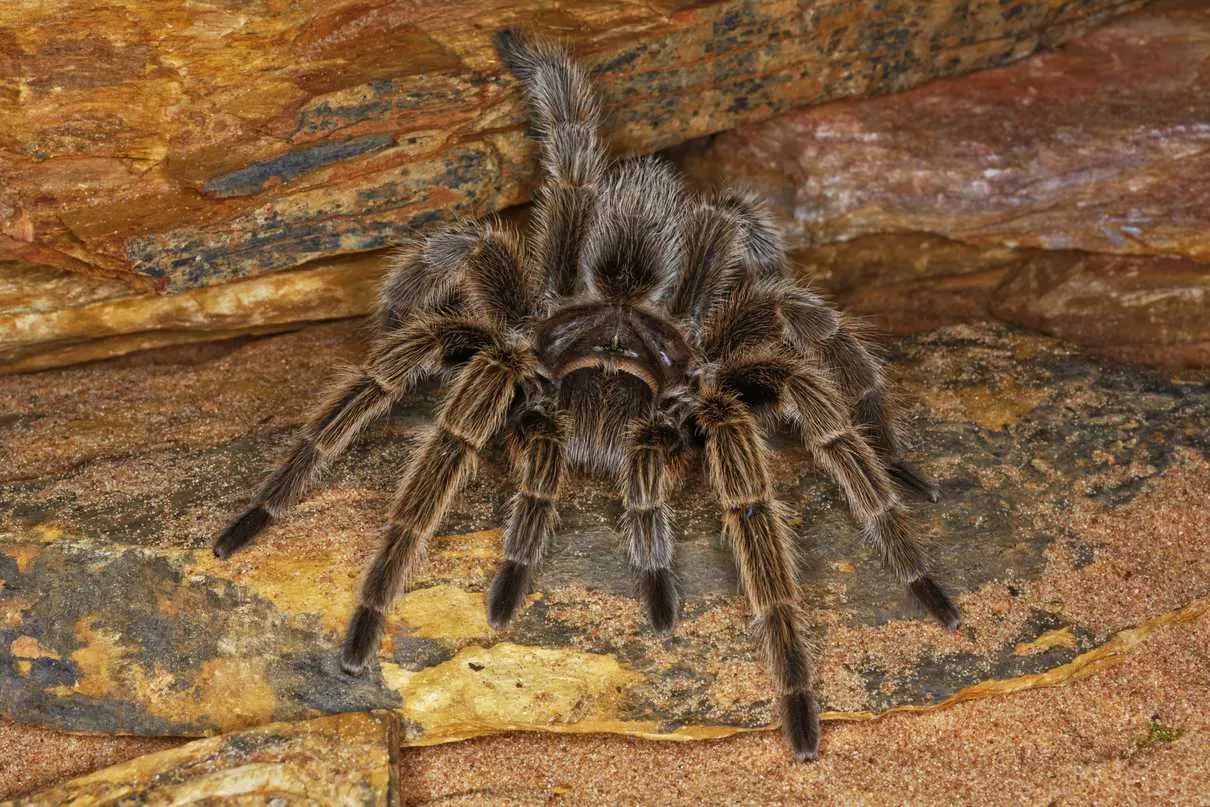What Makes a Tarantula Uncommon
The world of tarantulas is incredibly diverse, with hundreds of species exhibiting a wide array of colors, sizes, and behaviors. While some are commonly found in the pet trade and are relatively easy to obtain, others are incredibly rare and difficult to find. The factors that contribute to a tarantula’s uncommon status can vary, but often include limited natural habitats, specific environmental requirements, and challenges in captive breeding. Some species may be restricted to a small geographical area, making them less accessible to collectors and enthusiasts. Others may have intricate care needs that make them unsuitable for novice keepers. Furthermore, successful captive breeding can be difficult, leading to limited availability and higher prices. The appeal of owning an uncommon tarantula often lies in the unique characteristics, the challenge of providing proper care, and the prestige associated with possessing a rare and unusual specimen. Understanding the factors that make a tarantula uncommon is the first step towards appreciating these remarkable creatures.
The Pink Zebra Beauty
The Pink Zebra Beauty (Cyriocosmus elegans) is a small, striking tarantula known for its vibrant pink and black striped pattern. This New World species is relatively docile and makes a beautiful addition to any collection. The Pink Zebra Beauty’s unique coloration sets it apart from many other tarantulas, making it a favorite among enthusiasts. While not necessarily the rarest tarantula on this list, its striking appearance and small size contribute to its desirability and make it a popular choice for collectors seeking an eye-catching specimen. They are highly sought after due to their distinctive appearance, which is a result of the pink hairs contrasting with the black stripes. Their small size is also a factor in their appeal, as they require less space than many larger tarantula species. This species, therefore, has a devoted following within the tarantula community.
Appearance and Characteristics
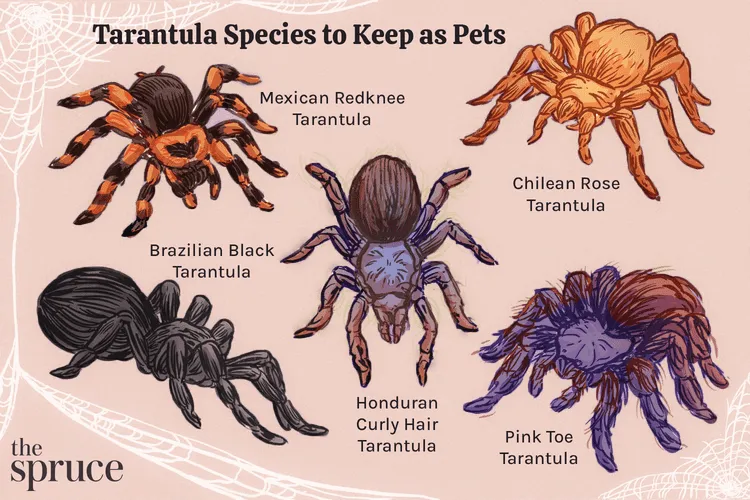
The Pink Zebra Beauty stands out due to its vibrant coloration. The carapace and legs display a pattern of alternating pink and black stripes. The abdomen is typically black with some pink hairs. Their small size, typically reaching only about 1-2 inches in leg span, makes them a delightful option for hobbyists with limited space. Their temperament is typically docile, making them relatively easy to handle if necessary, although caution should always be exercised when dealing with any tarantula. The overall appearance is undeniably beautiful, making it a visually stunning addition to any collection. The combination of vibrant colors and manageable size makes the Pink Zebra Beauty an appealing and manageable species for both novice and experienced keepers alike. These characteristics contribute significantly to its popularity within the tarantula community.
Habitat and Care
Caring for a Pink Zebra Beauty involves providing a suitable enclosure with a substrate of coco fiber or peat moss. A shallow water dish is essential for hydration, and the enclosure should be kept at a temperature between 75-80°F (24-27°C). Humidity should be maintained at around 60-70%. Feeding consists of small insects like crickets, mealworms, or roaches, offered 1-2 times per week, depending on the tarantula’s size and feeding habits. The enclosure should include hiding places such as cork bark or artificial plants to provide security. These tarantulas are known for their docile nature, making them relatively easy to manage. Regular misting will help maintain the necessary humidity levels, but avoid overwatering. Providing a secure and comfortable environment is the key to successfully keeping this beautiful species.
The Cobalt Blue Tarantula
The Cobalt Blue Tarantula (Cyriopagopus lividus) is a stunning species admired for its iridescent blue coloration. Native to Myanmar and Thailand, this Old World tarantula offers a captivating display of color. While beautiful, they are known for a more defensive temperament and are not recommended for beginners. Their striking blue hue is especially vibrant, making them a visual masterpiece within the tarantula world. Their appeal extends to the exotic appearance of the species, which is often difficult to find in the pet trade. These tarantulas, however, must be handled carefully, as they are more likely to exhibit defensive behaviors when threatened. This highlights the importance of understanding the needs of this species before adding one to your collection.
Appearance and Characteristics
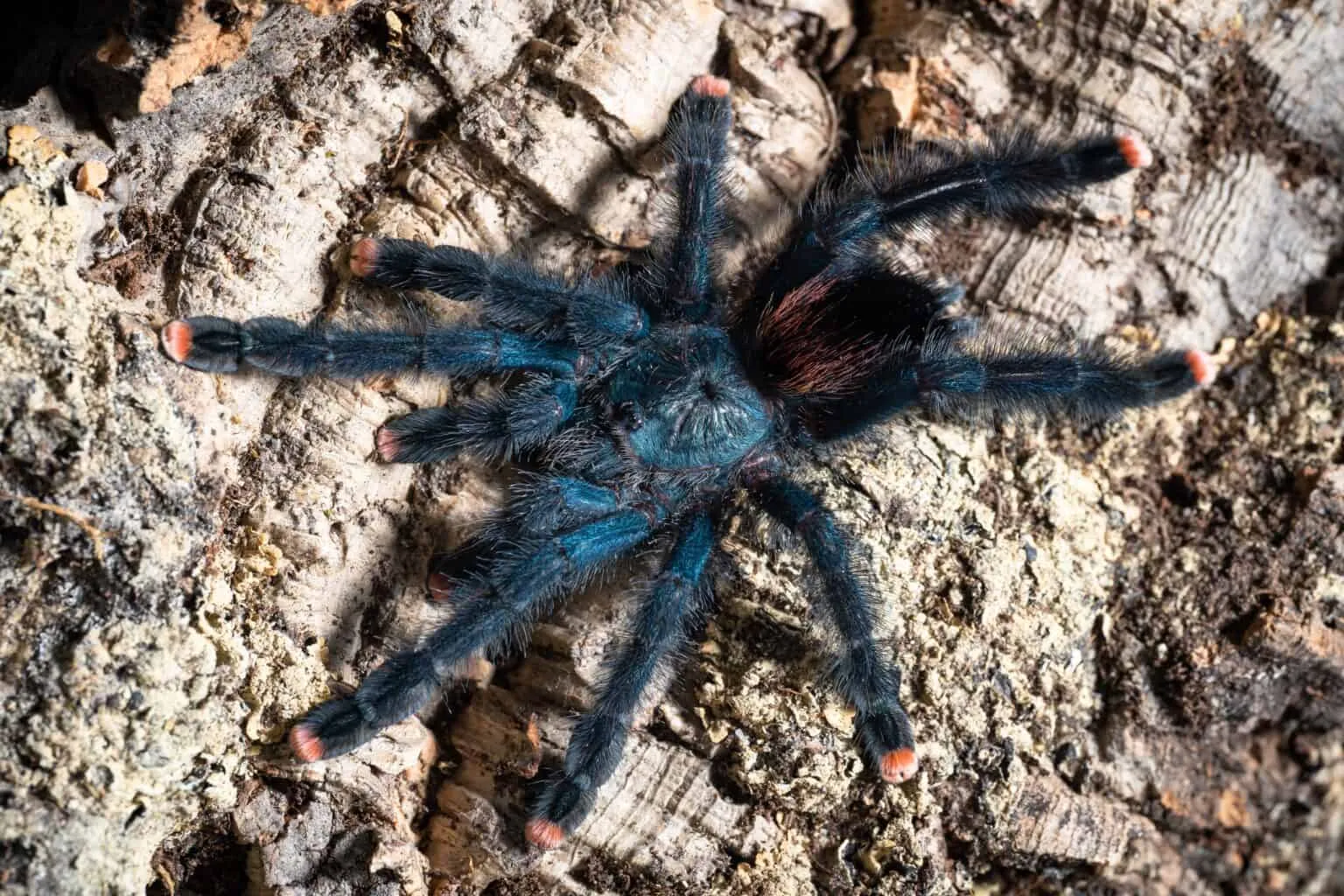
The Cobalt Blue Tarantula is immediately recognizable by its brilliant blue coloration, which is most prominent on the legs and carapace. The abdomen often displays a more muted blue or black color, creating a striking contrast. They are a medium-sized species, with a leg span reaching up to 5-6 inches. Their appearance is undeniably eye-catching, making them a highly sought-after species for experienced keepers. This is one reason why they have become popular as pet tarantulas. The combination of their striking appearance and the relative ease with which they can be kept makes them a worthwhile choice for experienced hobbyists. Their vibrant blue color makes them stand out. They are often kept in specialized terrariums that complement the color scheme of these beautiful arachnids.
Habitat and Care
Caring for a Cobalt Blue Tarantula requires a moderate level of experience. A secure enclosure with a deep substrate of coco fiber or a similar material is essential for burrowing. Temperatures should be maintained between 75-85°F (24-29°C), and humidity levels should be kept around 70-80%. A water dish should always be available, and the enclosure should include a secure hide. Feeding consists of a variety of insects, such as crickets, roaches, and mealworms, offered once or twice a week. This species can be more defensive and faster than other tarantulas, so caution should be exercised when handling or maintaining the enclosure. Their burrowing behavior requires providing a habitat that allows them to express their natural behaviors. A well-designed enclosure is vital for the long-term health and well-being of this species.
The Brazilian White Knee Tarantula
The Brazilian White Knee Tarantula (Acanthoscurria geniculata) is a large, impressive tarantula known for its striking black and white markings. While not exceedingly rare, its size and beauty make it a popular choice for tarantula enthusiasts. It is a New World terrestrial species, making it relatively easy to care for compared to some other species. Their appearance, particularly the white bands on their legs contrasting with the black body, makes them a highly desirable species for keepers and collectors alike. This tarantula, native to Brazil, is a great choice for those who prefer terrestrial habitats, and their relatively calm temperament adds to the appeal. They exhibit a good appetite, making them easier to feed than other, more finicky species. This makes them well-regarded in the community.
Appearance and Characteristics
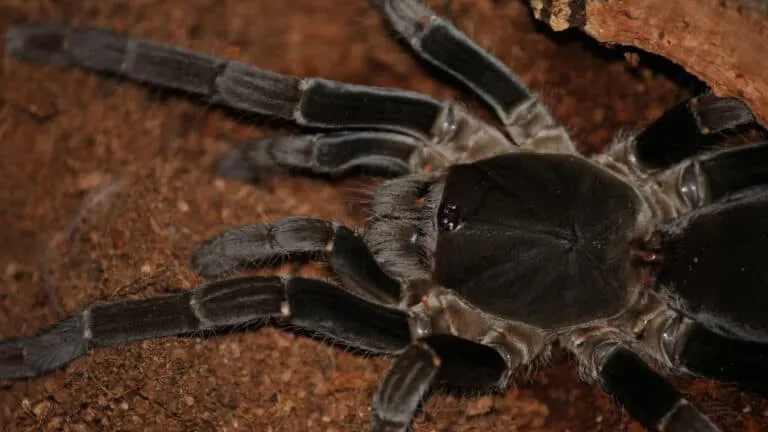
The Brazilian White Knee Tarantula is immediately recognizable by its black body and white or cream-colored bands on its legs. These bands become more pronounced with each molt, making the mature specimens visually stunning. They can reach a leg span of up to 8-9 inches, making them one of the larger tarantula species commonly kept in captivity. They are known for their hardy nature and relatively docile temperament, making them a favorite among tarantula keepers. The contrast between the dark body and the white stripes is very striking, and these tarantulas are, therefore, a visually appealing addition to any collection. The size and striking patterns contribute significantly to their appeal, solidifying their position as a popular choice for both experienced and novice keepers alike.
Habitat and Care
Caring for a Brazilian White Knee Tarantula involves providing a spacious enclosure with a deep substrate of coco fiber or peat moss. A hide, such as cork bark, is essential to provide security, along with a shallow water dish for hydration. Temperatures should be maintained between 75-85°F (24-29°C), and humidity levels around 60-70%. Feeding consists of a variety of insects, such as crickets, roaches, and mealworms, offered once or twice a week, depending on the tarantula’s size and appetite. These tarantulas are known for their voracious appetites, and care should be taken to avoid overfeeding. Regular maintenance, including removing uneaten food and maintaining a clean enclosure, is vital for maintaining the health of this impressive species. Creating a suitable habitat helps ensure the long-term health and well-being of these magnificent creatures.
The King Baboon Tarantula
The King Baboon Tarantula (Pelinobius muticus) is an Old World species with a formidable appearance and a distinct burrowing behavior. Although not the most colorful, its imposing size and robust build make it a captivating addition to any collection. They are known for their fast growth rate and hardy nature, and they are relatively accessible in the pet trade. They are known to exhibit territorial behavior, and while not the best choice for novice keepers, they are rewarding for experienced handlers who appreciate their distinctive characteristics. Their large size and distinctive burrowing habits make them a fascinating species to observe and care for. The King Baboon’s imposing presence and the rewards associated with its successful care contribute to the appreciation for this species among enthusiasts.
Appearance and Characteristics
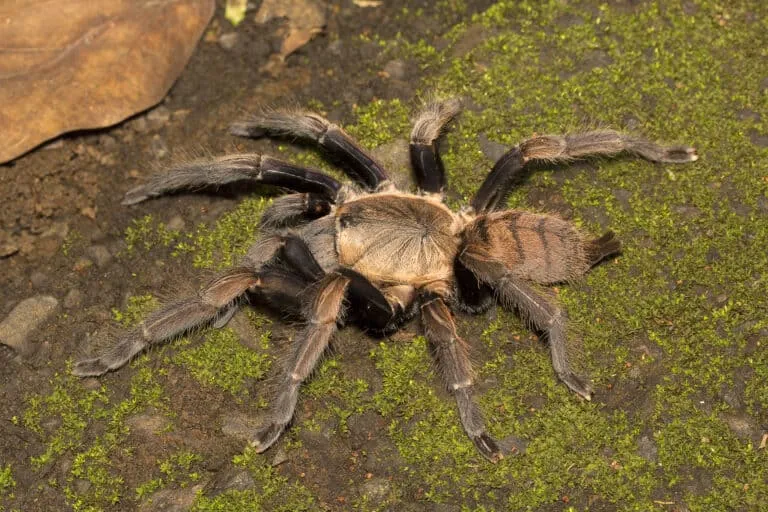
The King Baboon Tarantula has a robust build and a typically brown or tan coloration. Their most distinctive characteristic is their burrowing behavior, which is driven by their natural instincts. They can reach a leg span of up to 7-8 inches and are known for their relatively fast growth rate. They possess a powerful presence, and their habit of creating elaborate burrows adds another layer of intrigue to their appeal. Their color may vary from a light tan to a darker brown, with some specimens exhibiting subtle variations. Their size and presence are enhanced by their burrowing behavior, making them a captivating species for keepers who value robust spiders. The King Baboon’s physical attributes, combined with their engaging behaviors, solidify their place as a captivating species in the tarantula community.
Habitat and Care
Caring for a King Baboon Tarantula requires a deep substrate of at least 8-12 inches of coco fiber or a similar material, allowing for burrowing behavior. A water dish is essential for hydration, and the enclosure should be kept at a temperature between 75-85°F (24-29°C) with a humidity level of around 60-70%. Feeding should consist of a variety of insects, offered once or twice a week. The enclosure must be kept secure as these tarantulas are powerful diggers. Their burrowing behavior is a natural instinct and must be accommodated to provide a suitable habitat. A well-designed enclosure, along with proper feeding practices, is critical for maintaining the health and well-being of these fascinating arachnids. Providing an optimal habitat is a key to ensure that the spider lives and thrives.
The Socotra Island Blue Baboon Tarantula
The Socotra Island Blue Baboon Tarantula (Monocentropus balfouri) is an Old World tarantula found on the Socotra Island, and its unique appearance and social behavior make it a fascinating species. They are known for their communal living habits and stunning coloration, with their metallic blue or purple legs. This tarantula, found in a remote location, has become increasingly popular in the pet trade due to its unique features. Their intriguing social behavior, which includes living in colonies, sets them apart. These factors enhance the appeal of the species to enthusiasts who seek something distinctive. Their fascinating behaviors add to their attractiveness, particularly among experienced tarantula keepers. This species, therefore, has become a favorite of those seeking to create a vibrant collection.
Appearance and Characteristics

The Socotra Island Blue Baboon Tarantula is characterized by its metallic blue or purple legs, contrasting with its tan or brown body. The appearance is striking, especially as they mature. This species can reach a leg span of about 5-6 inches, and their striking appearance adds to their appeal. Their legs appear stunning under the proper lighting, and the contrast with the body is noticeable. This species’ coloration makes them sought after in the tarantula community. Their appearance, coupled with their social behaviors, positions them as a captivating species for both experienced and enthusiastic keepers.
Habitat and Care
This species can be kept communally, but individual enclosures are also suitable. A deep substrate of coco fiber or similar material is essential for burrowing, and a water dish should be available. Temperature should be maintained between 75-85°F (24-29°C), with humidity levels around 60-70%. These tarantulas are social creatures, and communal housing is an option, but the enclosure should be well-maintained. These tarantulas require a secure environment, and proper habitat management is essential for their well-being. Feeding should consist of appropriately sized insects, and a well-maintained enclosure will ensure a thriving environment for these unique creatures. They make a captivating addition to any collection with a bit of planning.
The Gooty Sapphire Ornamental Tarantula
The Gooty Sapphire Ornamental Tarantula (Poecilotheria metallica) is one of the most visually striking tarantulas, prized for its metallic blue and yellow coloration. This arboreal species from India is a favorite among experienced keepers, and they are known for their intricate web-making behavior. The colors combined with their elaborate webbing makes them a showpiece in the tarantula world. This species’ colors make it a favorite among tarantula enthusiasts. Their arboreal habits and need for a spacious enclosure create an exciting challenge to the keeper. The beauty of the Gooty Sapphire Ornamental is undeniable, and it is often considered to be the most beautiful species among tarantulas.
Appearance and Characteristics
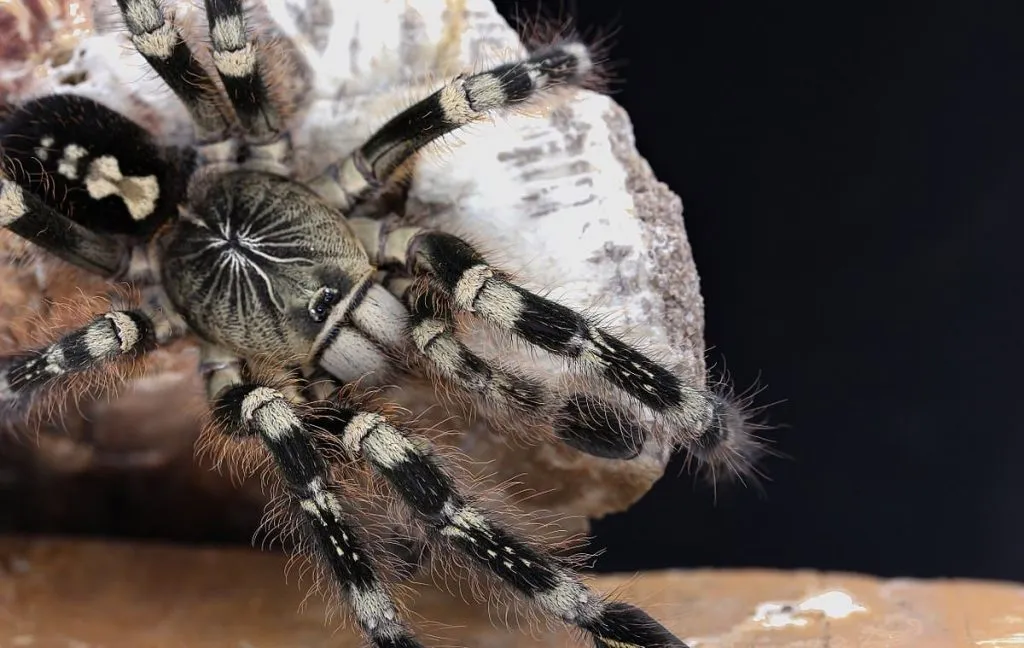
The Gooty Sapphire Ornamental Tarantula is easily recognizable by its striking coloration. The carapace and legs exhibit a vibrant blue or metallic purple hue, contrasted with yellow or orange markings on the legs and abdomen. This species reaches a leg span of up to 8-9 inches. The patterns make them easily recognizable and are a prime example of tarantula beauty. The combination of blue and yellow creates a mesmerizing effect. The Gooty Sapphire’s appearance is a true spectacle, making it a favorite for the visually inclined. The colors are extremely noticeable, and it is very attractive. The beauty adds another layer of attraction.
Habitat and Care
Caring for a Gooty Sapphire Ornamental Tarantula requires an arboreal enclosure with plenty of vertical space. A tall enclosure is necessary for them to express their natural behaviors. Temperatures should be maintained between 75-85°F (24-29°C), with humidity levels around 70-80%. A water dish should be available, and a secure hide is necessary. Feeding should consist of appropriately sized insects, and a well-ventilated enclosure will support the overall health of this beautiful species. These tarantulas’ arboreal needs require a well-thought-out enclosure. The setup includes a spacious environment that accommodates their distinctive behavior. Providing a suitable habitat is the key to ensuring their health.
The Chaco Golden Knee Tarantula
The Chaco Golden Knee Tarantula (Grammostola pulchripes) is a popular, hardy, and generally docile species known for its striking golden-colored knees. While not exceedingly rare, its size, beauty, and gentle temperament make it a favorite among beginners and experienced keepers. This South American species is known for its manageable care requirements. It is one of the most approachable tarantulas and offers a rewarding experience to those who decide to keep it. Their gentle demeanor makes them a great choice for those starting out in the hobby. Their beautiful knees also have the golden colors that everyone loves. The popularity among beginners is because they are easy to manage and they have a gentle disposition.
Appearance and Characteristics
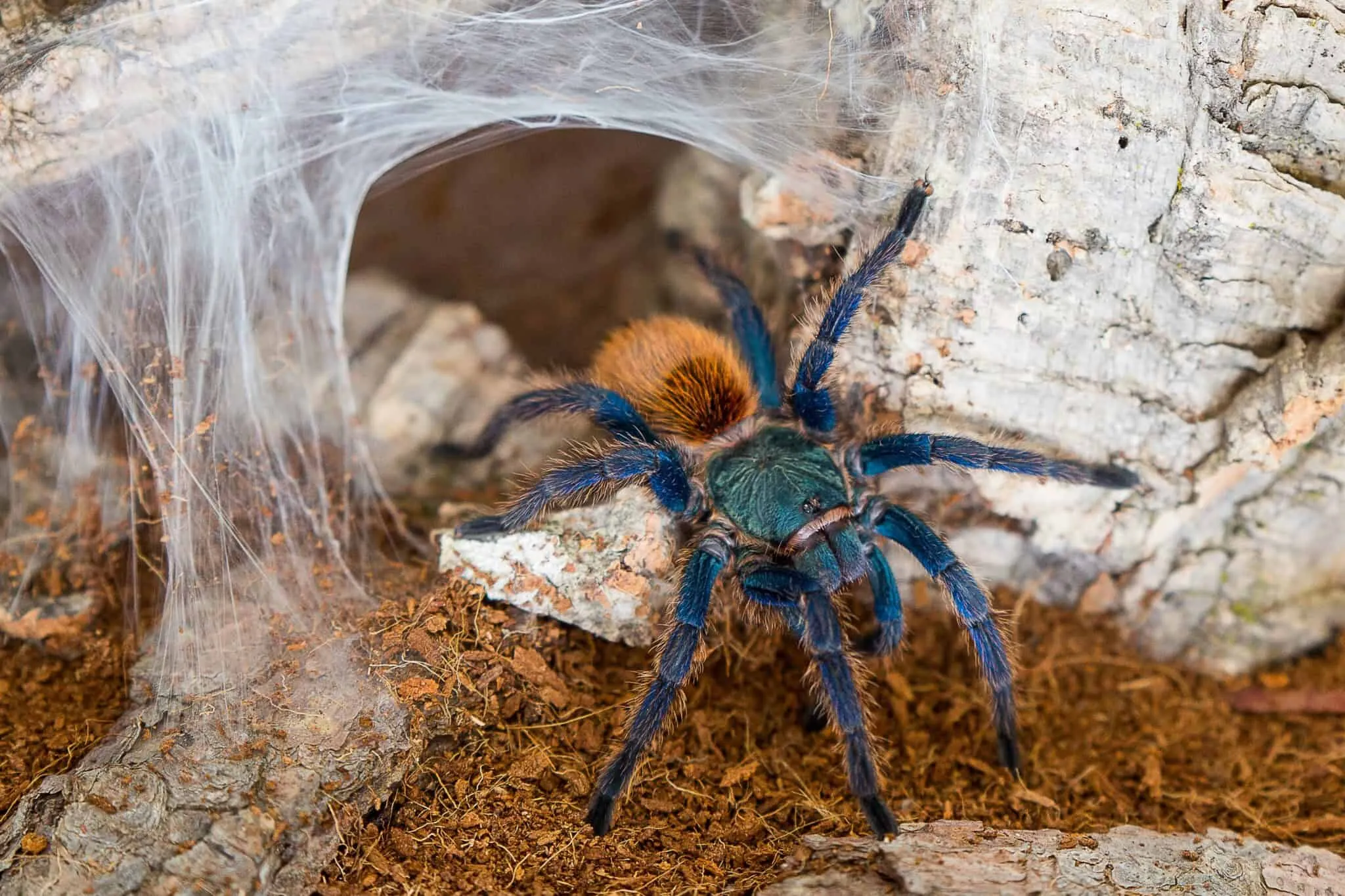
The Chaco Golden Knee Tarantula is characterized by its black body and the distinctive golden-colored bands on its knees. They can reach a leg span of up to 7-8 inches. The appearance is very striking and is very popular among tarantula keepers. Their gentle temperament makes them a favorite among tarantula enthusiasts. The size and beauty make them a great addition to any collection. Their overall appearance is very beautiful, and their temperament is also very well-suited for handling. The attractiveness is one of the main reasons that they are so popular, and beginners love them.
Habitat and Care
Caring for a Chaco Golden Knee Tarantula involves providing a terrestrial enclosure with a substrate of coco fiber or peat moss. A water dish should be available, and a hide, such as cork bark, is essential for security. Temperatures should be maintained between 70-80°F (21-27°C), and humidity levels should be kept around 60-70%. Feeding should consist of a variety of insects, offered once or twice a week. This species is known for its relatively easy care requirements, making it a good choice for both beginners and experienced keepers. The right care ensures the long-term health and well-being of these beautiful and manageable tarantulas. Creating a safe and secure environment is key to keeping the Chaco Golden Knee healthy.
Conclusion
The world of uncommon tarantulas offers a fascinating glimpse into the diversity and beauty of the arachnid world. From the iridescent Cobalt Blue to the striking Pink Zebra Beauty, each species presents unique characteristics and care requirements. While the allure of owning these rare creatures is undeniable, it’s crucial to prioritize responsible ownership. Researching the specific needs of each species, providing a suitable habitat, and understanding their temperament are all essential for the well-being of these remarkable animals. Whether you’re a seasoned enthusiast or a curious beginner, exploring the world of uncommon tarantulas is a rewarding experience. By appreciating their unique characteristics and respecting their needs, we can help to ensure their survival and preserve their beauty for generations to come.
